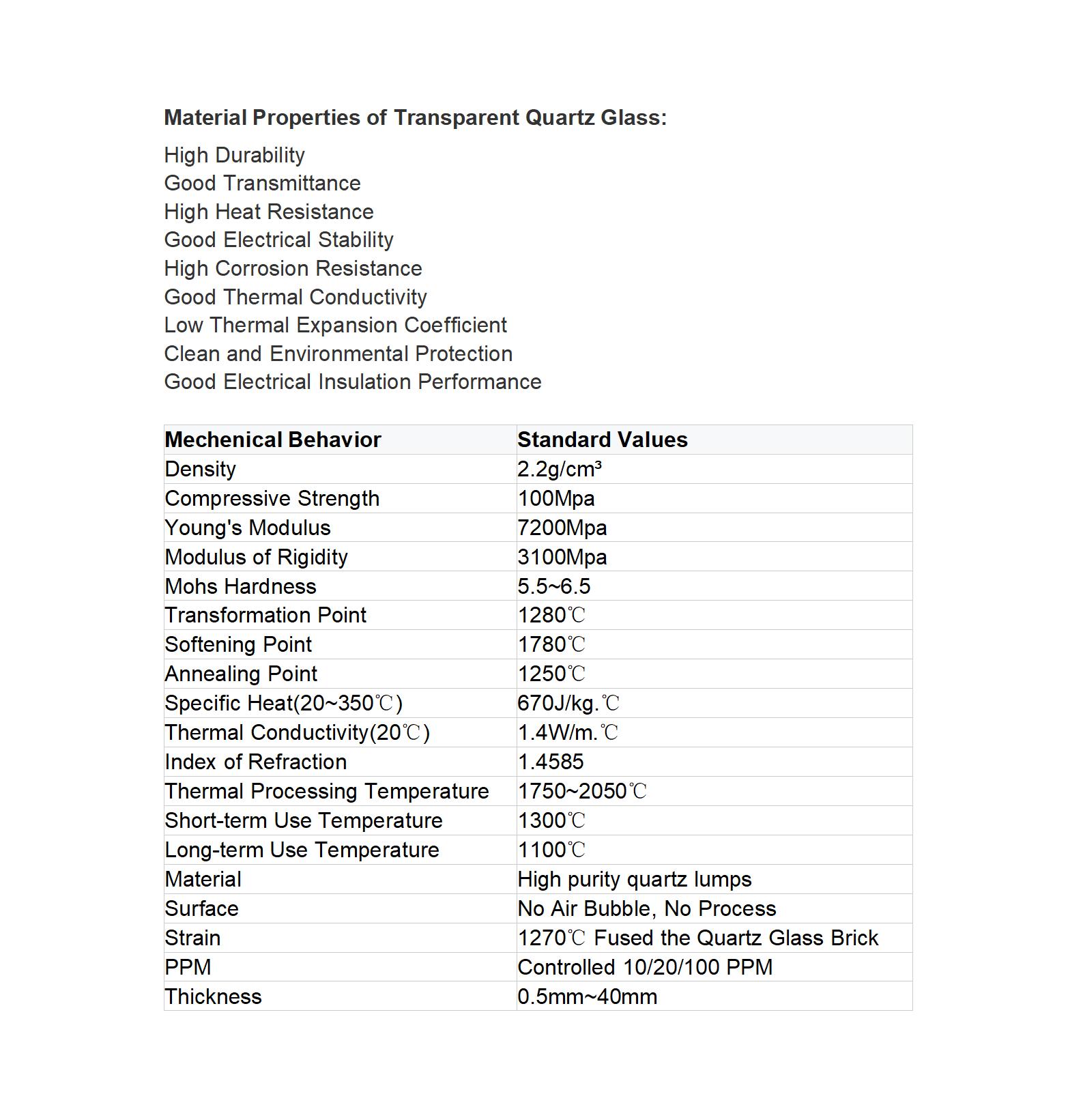T: +86-518-85528012
E: nick@luverrequartz.com
E: nick@luverrequartz.com
1st floor Runlian industrial center No. 116 QuFeng Rd., Haizhou Economic and technological development zone Lianyungang City, Jiangsu Province, China 222062
CVD furnace transparent cylindrical quartz tube
Transparent cylindrical quartz tubes used in CVD (Chemical Vapor Deposition) furnaces are essential components in semiconductor manufacturing and other high-tech industries.
LUVERRE quartz
99.99%
Inner with Vacuum PVC bag and then wrapped with air bubble film, outer with wooden box.
as per customer's requirement
| Availability: | |
|---|---|
CVD furnace transparent cylindrical quartz tube
Transparent cylindrical quartz tubes used in CVD (Chemical Vapor Deposition) furnaces are essential components in semiconductor manufacturing and other high-tech industries. The excellent optical transparency and excellent physicochemical properties of these quartz tubes ensure that precise chemical reactions can proceed smoothly in high-temperature and high-purity environments.
Material properties
- High purity silica: The use of more than 99.99% purity of SiO2 raw materials guarantees a very low metal impurity content, which is essential for maintaining the purity of the gas environment during the CVD process.
Exceptional light transmittance: up to 90% or more of visible light transmittance allows researchers to directly observe chemical changes taking place inside, which is very helpful for monitoring the reaction process.
- High temperature resistance: capable of withstanding operating temperatures exceeding 1100 ° C without softening or deformation, meeting the high temperature requirements commonly found in CVD processes.
Chemical inertness: It exhibits good corrosion resistance to most chemicals, even in environments containing halogens or other strong oxidizing agents.
Low coefficient of thermal expansion: This guarantees the dimensional stability of the quartz tube during heating and cooling cycles, reducing the risk of stress and cracking due to temperature fluctuations.

Design features
Seamless construction: Manufactured using advanced melt drawing technology, there are no seams, reducing the risk of leakage and enhancing overall strength.
- Uniform wall thickness: Ensure the same thickness over the entire length, thus achieving uniform heat distribution, which helps to control the reaction conditions.
Precise Dimensions: Offers a wide range of standard specifications, while supporting customization services to meet the needs of different customers, including diameters, lengths, and special shapes.
Application scenario
CVD furnace transparent cylindrical quartz tubes are widely used in the following fields:
Semiconductor manufacturing: used to grow high-quality single or polycrystalline thin film materials such as silicon, gallium arsenide, etc.
- LED Production: Provides an ideal reaction vessel for epitaxial layer growth of GaN-based Light Emitting Diodes.
Photovoltaic industry: suitable for coating processes in the manufacturing of solar panels.
Scientific research: as an experimental reactor for the exploration of new materials under laboratory conditions.

With its unique material characteristics and design advantages, the transparent cylindrical quartz tube of CVD furnace has become an indispensable and important part in many advanced manufacturing industries. It not only promotes the efficient and stable chemical vapor deposition process, but also provides researchers with an intuitive and convenient operation experience.
CVD furnace transparent cylindrical quartz tube
Transparent cylindrical quartz tubes used in CVD (Chemical Vapor Deposition) furnaces are essential components in semiconductor manufacturing and other high-tech industries. The excellent optical transparency and excellent physicochemical properties of these quartz tubes ensure that precise chemical reactions can proceed smoothly in high-temperature and high-purity environments.
Material properties
- High purity silica: The use of more than 99.99% purity of SiO2 raw materials guarantees a very low metal impurity content, which is essential for maintaining the purity of the gas environment during the CVD process.
Exceptional light transmittance: up to 90% or more of visible light transmittance allows researchers to directly observe chemical changes taking place inside, which is very helpful for monitoring the reaction process.
- High temperature resistance: capable of withstanding operating temperatures exceeding 1100 ° C without softening or deformation, meeting the high temperature requirements commonly found in CVD processes.
Chemical inertness: It exhibits good corrosion resistance to most chemicals, even in environments containing halogens or other strong oxidizing agents.
Low coefficient of thermal expansion: This guarantees the dimensional stability of the quartz tube during heating and cooling cycles, reducing the risk of stress and cracking due to temperature fluctuations.

Design features
Seamless construction: Manufactured using advanced melt drawing technology, there are no seams, reducing the risk of leakage and enhancing overall strength.
- Uniform wall thickness: Ensure the same thickness over the entire length, thus achieving uniform heat distribution, which helps to control the reaction conditions.
Precise Dimensions: Offers a wide range of standard specifications, while supporting customization services to meet the needs of different customers, including diameters, lengths, and special shapes.
Application scenario
CVD furnace transparent cylindrical quartz tubes are widely used in the following fields:
Semiconductor manufacturing: used to grow high-quality single or polycrystalline thin film materials such as silicon, gallium arsenide, etc.
- LED Production: Provides an ideal reaction vessel for epitaxial layer growth of GaN-based Light Emitting Diodes.
Photovoltaic industry: suitable for coating processes in the manufacturing of solar panels.
Scientific research: as an experimental reactor for the exploration of new materials under laboratory conditions.

With its unique material characteristics and design advantages, the transparent cylindrical quartz tube of CVD furnace has become an indispensable and important part in many advanced manufacturing industries. It not only promotes the efficient and stable chemical vapor deposition process, but also provides researchers with an intuitive and convenient operation experience.